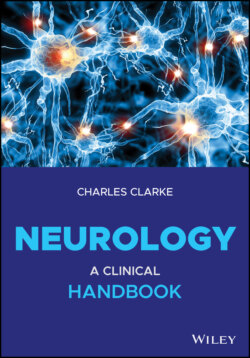Читать книгу Neurology - Charles H. Clarke - Страница 44
Brainstem
ОглавлениеI find that four points of reference simplify this region:
Each cranial nerve nucleus denotes a different level in the rostral–caudal plane.
Motor pathways lie ventrally.
Sensory pathways lie dorsally.
Reticular formation (RF) nuclei: most lie laterally, but the magnus raphe & median raphe nuclei are midline.
In our invertebrate ancestors, the brainstem was almost the entire forebrain. Olfaction and other sensations were connected, via the brainstem reticular formation (RF) to various movements – and thus to alertness, feeding and survival. With the evolution of the cerebral cortex, the brainstem became, in addition, a conduit connecting cranial nerve nuclei, cortex, cerebellum and cord, but remained the site of the RF and its connections – hence its complexity. What is needed is a general grasp of the levels of these brainstem nuclei (Figure 2.10).
Figure 2.10 Brainstem: lateral view – cranial nerve nuclei.
Source: Hopkins (1993).
The way in which the nuclear arrangements arose is explained by a brief embryological perspective. Seven nuclear columns develop into cranial nerve nuclei.
Motor cranial nerve nuclei:
III, IV, VI and XII arise from a paramedian nuclear mass – known as the general somatic efferent (GSE) column.
V (motor), VII, IX and X (nucleus ambiguus) and XI (spinal accessory nucleus) arise from ventro‐lateral cells – the special visceral efferent (SVE) and general visceral efferent (GVE) columns.
Afferent columns (general & special somatic and visceral afferents – GSA, SSA, SVA, GVA) develop into:
Vth nerve nuclei
Vestibular nuclei
Tractus solitarius nucleus (taste).
